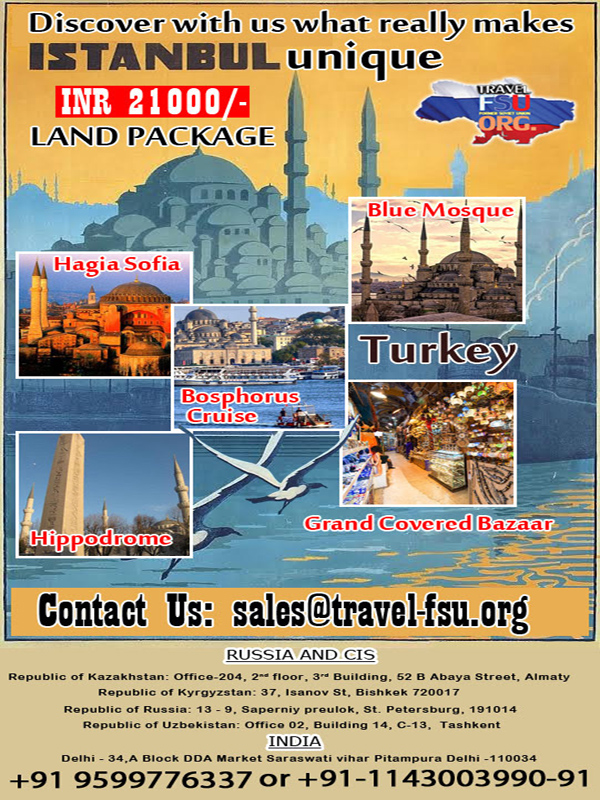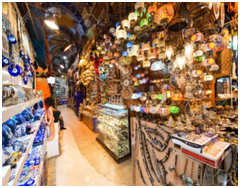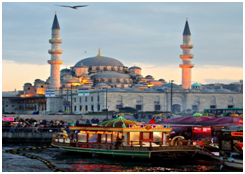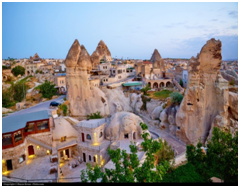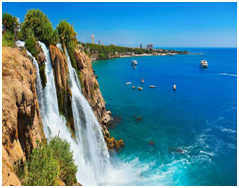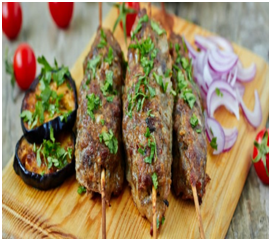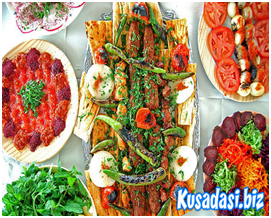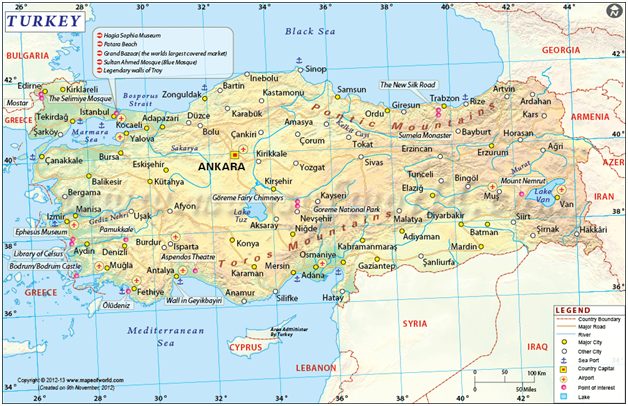Turkey ( i/ˈtÉœËrki/; Turkish: Türkiye [ˈtyɾcije]), officially the Republic of Turkey is a transcontinental parliamentary republic in Eurasia, mainly on the Anatolian peninsula in Western Asia, with a smaller portion on the Balkan peninsula in Southeast Europe.
Geography
Turkey is a democratic, secular, unitary, constitutional republic with a diverse cultural heritage. Turkey is bordered by eight countries: Greece to the west; Bulgaria to the northwest; Georgia to the northeast; Armenia, the Azerbaijani exclave of Nakhchivan and Iran to the east; and Iraq and Syria to the south. The Aegean Sea is to the west, the Black Sea to the north, and the Mediterranean Sea to the south. The Bosphorus, the Sea of Marmara, and the Dardanelles, which together form the Turkish Straits, divide Thrace and Anatolia; they also separate Europe and Asia.
Turkeys official language is Turkish, a Turkic language spoken natively by 84.5% of the population.
Turkey is a transcontinental Eurasian country. Asian Turkey, which includes 97 percent of the country, is separated from European Turkey by the Bosphorus, the Sea of Marmara, and the Dardanelles. European Turkey comprises 3 percent of the country. The territory of Turkey is more than 1,600 kilometers (990 miles) long and 800 kilometers (500 miles) wide, with a roughly rectangular shape. It lies between latitudes 35° and 43° N, and longitudes 25° and 45° E. Turkeys land area, including lakes, occupies 783,562 square kilometers (302,535 square miles), of which 755,688 square kilometers (291,773 square miles) are in Southwest Asia and 23,764 square kilometers (9,175 square miles) in Europe. Turkey is the worlds 37th-largest country in terms of area. The country is encircled by seas on three sides: the Aegean Sea to the west, the Black Sea to the north and the Mediterranean to the south. Turkey also contains the Sea of Marmara in the northwest.
Turkey is divided into seven geographical regions: Marmara, Aegean, Black Sea, Central Anatolia, Eastern Anatolia, Southeastern Anatolia and the Mediterranean. The uneven north Anatolian terrain running along the Black Sea resembles a long, narrow belt. This region comprises approximately one-sixth of Turkeys total land area. As a general trend, the inland Anatolian plateau becomes increasingly rugged as it progresses eastward.
Population
Population- In 2010, the population of Turkey was estimated to be 73.7 million with a growth rate of 1.21% per annum (2009 figure). The population is relatively young with 25.9% falling in the 0-14 age bracket. According to the OECD/World Bank population statistics, from 1990 to 2008 the population growth in Turkey was 16 million or 29%.
Transport
Rail Transport: The TCDD - Türkiye Devlet Demir Yolları (Turkish State Railways) possess 10,984 km of 1,435 mm(4 ft 8 1⁄2 in) gauge, of which 2,336 km are electrified (2005).
There are daily regular passenger trains all through the network.TCDD has started an investment program of building 5.000 km high-speed lines until 2023. By February 2014, three high speed train routes are running. Ankara-EskiÅŸehir, Ankara-Konya and EskiÅŸehir-Konya.
The freight transportation is mainly organized as block trains for domestic routes, since TCDD discourages under 200 to loads by surcharges.
In 2004, Marmaray project started on a rail tunnel under the Bosphorus straits. Between Istanbul and Ankara, a high speed railroad line is being constructed now next to the normal speed railroad which is being renovated. When finished, travel time between the two major cities will reduce from 6,5 hours to 3 hours and 10 minutes, using trains ordered from Spain that can reach up to 250 km/h. Construction of a high speed railroad line between Ankara and Konya was begun in order to connect the two cities with a direct line and reduced travel time from several hours to approximately one hour. The high speed railroad line between Ankara and Konya was finished on 3 June 2011 and was put into service on 23 August 2011.
Urban rail : Trams in Kayseri
After almost 30 years without any trams, Turkey is experiencing a revival in trams. Established in 1992, the tram system of Istanbul earned the best large-scale tram management award in 2005. Another award winning tram network belongs to EskiÅŸehir, (EsTram) a city with a new tram system opened in 2004. Several other cities are planning or constructing tram lines, usually with modern low-floow trams.
By 2014, there have been 12 cities in Turkey using metro, light rail and tram systems. They are Istanbul, Izmir, Ankara, Bursa, Eskisehir, Kayseri, Gaziantep, Konya, Samsun, Adana, Antalya and Adapazari. The total network is more than 500 kilometers and the rolling stock exceeds 1800 by now.
1. Cities with commuter rail systems: Istanbul, Ankara, Izmir
2. Cities with metro systems: Istanbul, Ankara, Izmir, Adana, Bursa
3. Cities with light rail transit systems: Istanbul, Ankara, Izmir, Adana, Bursa, EskiÅŸehir, Konya, Antalya, Kayseri, Gaziantep, Samsun
Road transport
Main article: There are two types of intercity roads in Turkey:
The first is the historical and free road network called State roads (Devlet Yolları) that are completely under the responsibility of the General Directorate of Highways except for urban sections (like the sections falling within the inner part of ring roads of Ankara, Istanbul or İzmir. Even if they mostly possess dual carriageways and interchanges, they also have some traffic lights and intersections.
The second type of roads are controlled-access highways that are officially named Otoyol. But it isnot uncommon that people in Turkey call them Otoban (referring to Autobahn) as this types of roads entered in popular culture by the means of Turks in Germany. They also depend on the General Directorate of Highways except the newest Otoyol 5 that is financed with a BOT model.
1. Total network: 426,906 km
2. Paved: 177,550 km (2004)
3. Motorways: 2,080 km (2010)
4. Dual carriageways: 16,784 km (2010)
5. Unpaved: 249,356 km (2004)
As of 2010, there are 155 tunnels (total length 99.5 km) and 6447 bridges (total length 296.3 km) on the network.
Air transport :
In 2013 Turkey had the tenth largest passenger air market in the world with 74,353,297 passengers
Airports - with paved runways
total: 88
over 3,047 m: 16
2,438 to 3,047 m:″ 33
1,524 to 2,437 m: 19
914 to 1,523 m: 16
under 914 m: 4 (2010) (Link:
Airports - with unpaved runways
total: 11
1,524 to 2,437 m: 1
914 to 1,523 m: 6
under 914 m: 4 (2010)
Heliports 20 (2010)
Water transport :
Ports and harbors
Black Sea
1. Hopa
2. Inebolu
3. Samsun
4. Trabzon
5. Zonguldak
Aegean Sea
1. Ä°zmir
Mediterranean Sea
1. Ä°skenderun
2. Mersin
3. Antalya
Sea of Marmara
1. Gemlik
2. Bandırma
3. Istanbul
4. Ä°zmit
5. Derince
Greetings
|
Welcome |
hoÅŸ geldiniz |
|
Hello |
Merhaba |
|
How are you? |
Nasılsınız? |
|
I am fine, thank you. |
Ä°yiyim, teÅŸekkür ederim. |
|
Good morning, good day |
Günaydın |
|
Good evening |
Ä°yi akÅŸamlar |
|
Good night |
Ä°yi geceler |
|
Goodbye |
Allaha ısmarladık |
|
What is your name? |
Adınız ne? |
|
My name is… |
Adım… |
|
Pardon me |
Affedersiniz, pardon |
|
Yes/no |
Evet/hayır |
|
Please. |
Lütfen |
|
Help yourself. |
Buyurun(uz) |
|
Thanks. |
TeÅŸekkürler [or] SaÄŸ ol [or] Mersi |
|
You are welcome. |
Bir ÅŸey deÄŸil |
|
What? |
Ne? |
|
How? |
Nasıl? |
|
Who? |
Kim? |
|
Why? |
Niçin [or]neden? |
|
When? |
Ne zaman? |
|
Which one? |
Hangisi? |
|
What is this? |
Bu ne? |
|
What does it mean? |
Ne demek? |
|
Give me |
bana verin |
|
I want |
istiyorum |
|
this |
Bu(nu) |
Posters
Sights
Cuisine
Map
Itineraries
| Sr. No. | Itinerary Name | File |
| 1 | Istanbul Itinerary | View Itinerary |


